Home to the “Crocs” FC Population: 2,086,000
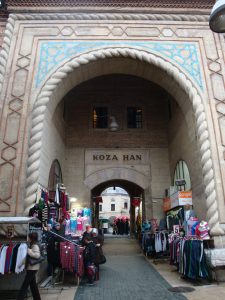 Old names: Prusa ad Olympum
Old names: Prusa ad Olympum
Favourite son: Mercan Dede (musician and artist)
Elegant early Ottoman mosques, spectacular ancient hamams, a sprawling covered bazaar and a great little street full of meyhanes (taverns).
Sound like İstanbul? In fact it’s Bursa, the thriving, self-confident city on the southeast side of the Sea of Marmara which was the Ottoman sultans’ original capital from 1326 to 1365 when it was replaced by Edirne.
Today tourism is something of an add-on to the serious business of manufacturing but for those in less of a hurry Bursa makes a great place to get a feel for the real Turkey while ticking off some excellent sightseeing too.
Mere hours from İstanbul across the Sea of Marmara, Bursa has a scarily busy one-way system that roars through the historic centre and it’s easy to whizz through town and barely realise what a lot it has to offer. That would be a great mistake because the suburbs that spin out from the centre are chock full of wonderful mosques, medreses and hamams dating back to the glory days of the early Ottoman Empire.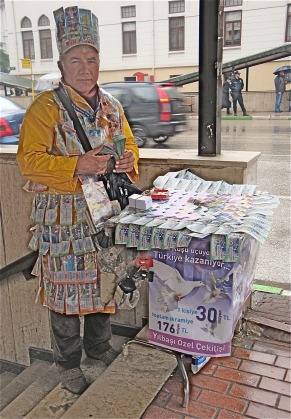
The obvious starting point for exploration is immediately north of busy Atatürk Caddesi where the Ulu Cami, with its 20 domes, makes an unmissable landmark. Dating back to 1396, it was built for Sultan Beyazıd Yıldırım (“the Thunderbolt”) as a thanks-offering after he managed to defeat the Crusaders.
The Ulu Cami has an appealingly austere splendour but many people fall more readily in love with the famous Yeşil Cami in the Emirsultan suburb on the eastern side of town which comes paired with the Yeşil Türbe (Green Tomb) housing the remains of the mosque’s founder Sultan Mehmed I. Actually “yeşil (green)” is a bit of a misnomer since the tiles on the tomb’s facade are really a turquoise blue. This is an especially pleasant area to wander around, with panoramic views back over the city and a number of fine old wooden houses.
You should also try and squeeze in a visit to the Muradiye complex on the western side of town. Here a mosque paid for in 1426 by Sultan Murad II is set in a lovely garden where a collection of 12 imperial tombs mingles with sweet-smelling box hedges. Most of the tombs house the remains of crown princes who fell victim to a system of inheritance that left the succession up to the strongest rather than the first-born son; the results were inevitably bloody as relatives turned on each other to ensure their own supremacy.
Nearby are a couple more small museums that may or may not be open: the Ottoman House Museum offers the chance to see what a typical home might have looked like in the 19th century, while the Hüsnü Züber Evi contains some interesting collections, including a set of wooden spoons whose delicacy will cast all those you’ll see on sale today into the shade. The Ulumay Museum of Ottoman Folk Costumes and Jewellery is housed in an old medrese. There is also a new Calligraphy Museum here.
Of course Bursa is much more than its mosques. Back in the part of the town centre marked by a statue of Atatürk and known universally as Heykel (Statue), the Bursa City Museum (closed Sundays and Mondays), housed in an old courthouse, is a state-of-the-art history museum with lots of bells and whistles and some wonderful recreations of old shops as well a great film clip showing local men using the upper parts of their bodies to beat felt into submission inside a local hamam.
A short walk away, the Tofaş Museum of Anatolian Carriages (closed Mondays) housed inside an old silk factory is a great place for the kids, with examples of everything that has ever rolled on wheels from old ox carts through to the latest limos.
Up in Tophane Park you can inspect the tombs of Osman, the first Ottoman sultan, and his son Orhan as rebuilt in the 19th century after an earthquake.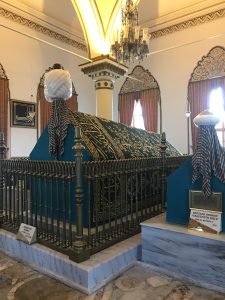
Across the road a gate leads into the Hisar (Citadel) area where restoration of the old houses and mosques is still ongoing.
Tombs of the sultans
Keen Ottoman enthusiasts will know that Bursa preceded İstanbul as the capital of the empire, and it’s here that a pursuit of the sultans’ burial places must start. Osman and Orhan, the father and son who established the dynasty in the 13th and 14th centuries, were laid to rest in tombs high up on a hill in what is now the Tophane part of town near the remains of the citadel. The original tombs fell foul of an earthquake in 1855, but replacements were provided by Sultan Abdülaziz in 1868.
Orhan’s son Murad I, victor at the momentous Battle of Kosovo in 1389, was buried a little further out of the town centre in the unique I. Murad (Hüdavendigar) Camii. His son was the unlucky Sultan Beyazıd I who was captured by Timurlane after the Battle of Ankara in 1402; thought to have been kept locked up in a cage, he may have killed himself in despair. His remains were buried in the Yıldırım Beyazıd Camii in the Emirsultan part of town across the valley from the ancestors who had founded his line.
Beyazıd’s son Sultan Mehmed I was buried in the exquisite Yeşil (Green) Camii that has become an icon of Bursa. But perhaps the most lovely of all the early imperial tombs in Bursa belongs to Sultan Murad II, the father of Mehmed the Conqueror, who was laid to rest in the exquisite Muradiye complex.
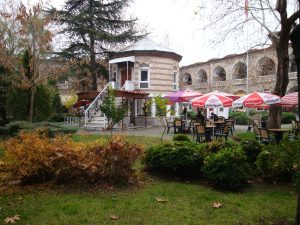 Shopping
Shopping
For shopaholics Bursa can certainly give Istanbul a run for its money. The most atmospheric place to offload your spare lira has to be the bazaar which spins off in all directions from around the Ulu Cami. What makes this such a magical place to shop is that you’ll find yourself wandering in and out of a series of delightful medieval hans where accommodation used to be provided for traders and their animals around a central courtyard.
Finest of all is the Koza (Cocoon) Hanı which dates back to 1490 and used to be the focal point of the local silk industry; even today most of the shops on the upper level sell silk scarves in every conceivable colour combination. Sundays aside, it’s a great place to while away a few hours.
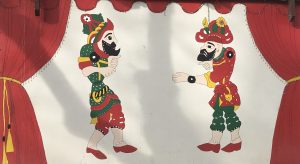 Amid the meandering bazaar streets there is one area that is actually called Kapalı Çarşı (Covered Market) like its better-known rival in İstanbul. The difference is that Bursa’s Kapalı Çarşı still exists to serve the locals, thus giving it an edge over the İstanbul version in some people’s eyes. Come here to stock up on the bath towels (havlu) and robes (bornoz) for which the city is famous (although they’re all machine-made these days), or to buy a Karagöz shadow puppet in the Aynalı Çarşı (Mirrored Market) housed inside an old hamam.
Amid the meandering bazaar streets there is one area that is actually called Kapalı Çarşı (Covered Market) like its better-known rival in İstanbul. The difference is that Bursa’s Kapalı Çarşı still exists to serve the locals, thus giving it an edge over the İstanbul version in some people’s eyes. Come here to stock up on the bath towels (havlu) and robes (bornoz) for which the city is famous (although they’re all machine-made these days), or to buy a Karagöz shadow puppet in the Aynalı Çarşı (Mirrored Market) housed inside an old hamam.
Like İstanbul, Bursa is rapidly acquiring the shopping-mall habit, and in an effort to fight back and keep the market alive, the city authorities has roofed over some of the streets that used to be open to the elements, a wise idea given that the huge glass pyramid of the undercover Zafer Plaza Shopping Mall is only a stone’s throw away down the hill.
The authorities were also responsible for the recent renovation of the picturesque Irgandı Bridge at Setbaşı which, like the Ponte Vecchio over the River Arno in Florence, is lined with small handicrafts shops.
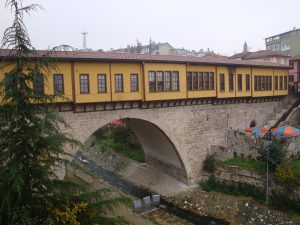
Hamams
Bursa is one of those wonderful Turkish towns that grew up around mineral springs that gush from the ground at temperatures perfect for bathing. No visit to the city would be complete without a trip out to the suburb of Çekirge (Grasshopper) to luxuriate in the Eski Kaplıca (Old Spa; Tel: 0224-233 9300. Open: 7am to 11pm).
Perhaps the most extraordinary thermal bath is also the most easily missed. It’s inside the partially Art Deco Hotel Çelik Palas, midway along the road between Hisar and Cekirge. The hotel owes its existence to Atatürk who had it built beside his own house to accommodate guests. Unfazed by the absence of a hot spring on the site, he then oversaw the building of a pipeline from Cekirge to guarantee them the same thermal delights as lesser mortals. Fading photographs reveal what a major undertaking this was.
It was in Bursa in 1867 that a cook named İskender first thought of grilling meat upright so that the dripping fat would self-baste it. The ensuing İskender (or Bursa) kebap consists of thin slices of lamb sliced from a revolving grill, laid on a bed of fluffy pide bread and served with a dollop of fresh yoghurt. To top it off, fresh tomato sauce and melted butter are dribbled over the top.
These days you can tuck into an İskender kebap anywhere in Turkey but there’s nothing better than sampling it in its home town. One of the best places to do this is at a branch of Kebapci İskender whose current owners are supposedly descended from the original İskender. Their town centre restaurant in Heykel makes great play with stained-glass windows and fancy décor (and attracts queues of would-be diners) but the Soğanlı branch, out in the suburbs, is more cheerful. What really gives Soğanlı the edge, though, is the chance to walk off a meaty lunch in the delightful and frequently overlooked botanical gardens afterwards.
Alternatively, Kayhan Caddesi at the eastern end of the bazaar and close to Setbaşı is lined with restaurants serving pideli köfte (meatballs on pide), a tasty and fairly cheap alternative to an İskender kebab. This is also a good area to look for a cantık, a round local pide on thick, squishy bread.
But surely the liveliest eating option is to head for Sakarya (“Arap Şükrü”) Caddesi, Bursa’s mezes-and-rakı-dispensing answer to İstanbul’s Nevizade Sokak, albeit on a smaller scale. Just a short walk downhill from the Ulu Cami, on a street once known for its synagogues. you’ll find a string of fish restaurants all touting the Arap Şükrü name. Your best bet is probably to look for the busiest – although be warned that that could also mean the noisiest! On a visit in 2023 I ate at Vida where the food was great but the musicians a deterrent to conversation.
Sleeping
Authentique Club. Tel: 0224-211 3280
Transport info
From İstanbul, İDO fast car ferries sail from Yenikapı to Güzelyalı and from Kabataş to Mudanya. Then you take a bus to Bursa Metro’s Organize Sanayı station. The Metro brings you to Şehreküstü, within walking distance of the bazaar.
BUDO also operates a catamaran passenger service from Sirkeci/Eminönü in İstanbul to Mudanya with onward connections into Bursa.
Bursa’s bus station (Terminal) is frustratingly far from the centre and connected to it by bus No 38; even in good traffic buses take roughly three quarters of an hour to reach the centre and it can be much longer. The T2 Metro line runs from the Terminal to the Kent Meydanı but you then need a bus to get you up the hill to the town centre. The taxi alternative will make an expensive start to your visit. To find the buses walk through the bus station to the front, passing through airport-style security on the way.
Butram operates three tram routes in Bursa: T1 operates between Gazcılar and Stadium. T2 runs from the Terminal to Kent Meydanı where it intersects with the T1. T3 (the nostalgic tram) trundles very slowly along Cumhuriyet Caddesi to the north of the bazaar area connecting Zafer Plaza and Çınarönü.
BursaRay operates two Metro lines in the city centre. Line 1 runs from Emek on the road to Mudanya and Line 2 from Üniversite on the road to İzmir. They meet at Acemeler and continue to Kestel, passing through Şekreküstü.
BursaKarts are rechargable public transport cards on sale at station and at a büfe near the Terminal. The cards cost TL50 so make sure you’re going to use one frequently enough to justify the cost. Otherwise you can pay to use buses etc with a contactless bankcard.
Dolmuşes run from behind the government building at Heykel to the Telerferik. Old-fashioned taxi-dolmuşes still run from in front of the Koza Han to Merinos and other destinations. Buses to Cumalıkızık leave from the middle of Atatürk Caddesi.
Be warned that crossing Atatürk Caddesi in the town centre is a scary business. There are a few underpasses but only one has an escalator. Watching old and disabled people, and people with children and animals trying to cross without using them is alarming.
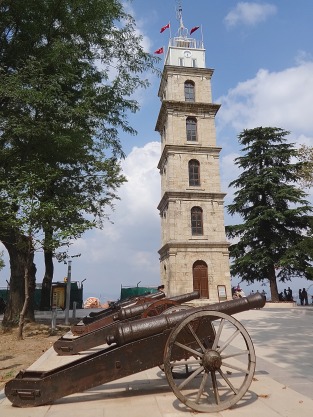 The clocktower in Tophane ParkAreas of Bursa
The clocktower in Tophane ParkAreas of Bursa
Bursa: Muradiye
Day trip destinations
Read more about the hans of old Bursa: Exploring the hans of old Bursa


